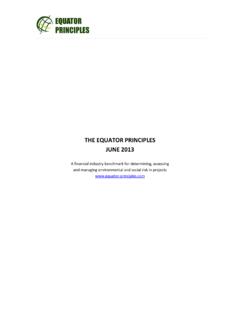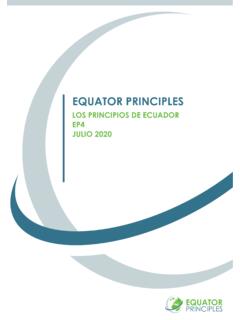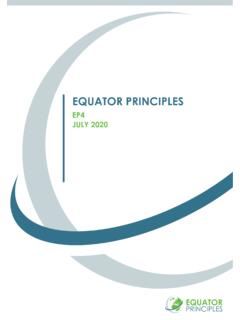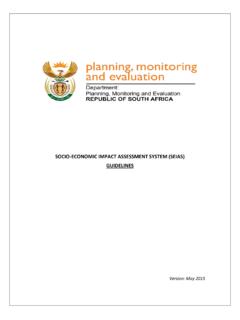Transcription of THE EQUATOR PRINCIPLES JUNE 2013
1 _____. THE EQUATOR PRINCIPLES . JUNE 2013. A financial industry benchmark for determining, assessing and managing environmental and social risk in projects _____. CONTENTS. PREAMBLE .. 2. 3. APPROACH .. 4. STATEMENT OF PRINCIPLES .. 5. Principle 1: Review and Categorisation .. 5. Principle 2: Environmental and Social Assessment .. 5. Principle 3: Applicable Environmental and Social 6. Principle 4: Environmental and Social Management System and EQUATOR PRINCIPLES Action 7. Principle 5: Stakeholder Engagement .. 7. Principle 6: Grievance 8. Principle 7: Independent Review .. 8. Principle 8: Covenants .. 9. Principle 9: Independent Monitoring and 10. Principle 10: Reporting and Transparency .. 10. DISCLAIMER .. 11. ANNEXES: IMPLEMENTATION REQUIREMENTS .. 12. Note: The implementation requirements detailed in these annexes are an integral part of the EQUATOR PRINCIPLES and are mandatory requirements for EQUATOR PRINCIPLES Financial Institutions.
2 Annex A - Climate Change: Alternatives Analysis, Quantification and Reporting of Greenhouse Gas Emissions .. 12. Annex B - Minimum Reporting Requirements .. 13. EXHIBITS: SUPPORTING INFORMATION .. 15. Exhibit I: Glossary of 15. Exhibit II: Illustrative List of Potential Environmental and Social Issues to be Addressed in the Environmental and Social Assessment Documentation .. 20. Exhibit III: IFC Performance Standards on Environmental and Social Sustainability and the World Bank Group Environmental, Health and Safety Guidelines .. 21. 1 June 2013. _____. PREAMBLE. Large infrastructure and industrial Projects can have adverse impacts on people and on the environment. As financiers and advisors, we work in partnership with our clients to identify, assess and manage environmental and social risks and impacts in a structured way, on an ongoing basis. Such collaboration promotes sustainable environmental and social performance and can lead to improved financial, environmental and social outcomes.
3 We, the EQUATOR PRINCIPLES Financial Institutions (EPFIs), have adopted the EQUATOR PRINCIPLES in order to ensure that the Projects we finance and advise on are developed in a manner that is socially responsible and reflects sound environmental management practices. We recognise the importance of climate change, biodiversity, and human rights, and believe negative impacts on project-affected ecosystems, communities, and the climate should be avoided where possible. If these impacts are unavoidable they should be minimised, mitigated, and/or offset. We believe that adoption of and adherence to the EQUATOR PRINCIPLES offers significant benefits to us, our clients, and local stakeholders through our clients' engagement with locally Affected Communities. We therefore recognise that our role as financiers affords us opportunities to promote responsible environmental stewardship and socially responsible development, including fulfilling our responsibility to respect human rights by undertaking due diligence 1 in accordance with the EQUATOR PRINCIPLES .
4 The EQUATOR PRINCIPLES are intended to serve as a common baseline and framework. We commit to implementing the EQUATOR PRINCIPLES in our internal environmental and social policies, procedures and standards for financing Projects. We will not provide Project Finance or Project-Related Corporate Loans to Projects where the client will not, or is unable to, comply with the EQUATOR PRINCIPLES . As Bridge Loans and Project Finance Advisory Services are provided earlier in the Project timeline, we request the client explicitly communicates their intention to comply with the EQUATOR PRINCIPLES . EPFIs review the EQUATOR PRINCIPLES from time-to-time based on implementation experience, and in order to reflect ongoing learning and emerging good practice. 1. As referenced in the Guiding PRINCIPLES on Business and Human Rights: Implementing the United Nations Protect, Respect and Remedy' Framework.
5 2 June 2013. _____. SCOPE. The EQUATOR PRINCIPLES apply globally and to all industry sectors. The EQUATOR PRINCIPLES apply to the four financial products described below when supporting a new Project: 1. Project Finance Advisory Services where total Project capital costs are US$10 million or more. 2. Project Finance with total Project capital costs of US$10 million or more. 3. Project-Related Corporate Loans 2 (including Export Finance in the form of Buyer Credit) where all four of the following criteria are met: i. The majority of the loan is related to a single Project over which the client has Effective Operational Control (either direct or indirect). ii. The total aggregate loan amount is at least US$100 million. iii. The EPFI's individual commitment (before syndication or sell down) is at least US$50. million. iv. The loan tenor is at least two years. 4. Bridge Loans with a tenor of less than two years that are intended to be refinanced by Project Finance or a Project-Related Corporate Loan that is anticipated to meet the relevant criteria described above.
6 While the EQUATOR PRINCIPLES are not intended to be applied retroactively, the EPFI will apply them to the expansion or upgrade of an existing Project where changes in scale or scope may create significant environmental and social risks and impacts, or significantly change the nature or degree of an existing impact. 2. Project-Related Corporate Loans exclude Export Finance in the form of Supplier Credit (as the client has no Effective Operational Control). Furthermore, Project-Related Corporate Loans exclude other financial instruments that do not finance an underlying Project, such as Asset Finance, acquisition finance, hedging, leasing, letters of credit, general corporate purposes loans, and general working capital expenditures loans used to maintain a company's operations. 3 June 2013. _____. APPROACH. Project Finance and Project-Related Corporate Loans The EPFI will only provide Project Finance and Project-Related Corporate Loans to Projects that meet the requirements of PRINCIPLES 1-10.
7 Project Finance Advisory Services and Bridge Loans Where the EPFI is providing Project Finance Advisory Services or a Bridge Loan, the EPFI will make the client aware of the content, application and benefits of applying the EQUATOR PRINCIPLES to the anticipated Project. The EPFI will request that the client communicates to the EPFI its intention to adhere to the requirements of the EQUATOR PRINCIPLES when subsequently seeking long term financing. The EPFI will guide and support the client through the steps leading to the application of the EQUATOR PRINCIPLES . For Bridge Loans categorised A or B (as defined in Principle 1) the following requirements, where relevant, apply. Where the Project is in the feasibility phase and no impacts are expected during the tenor of the loan, the EPFI will confirm that the client will undertake an Environmental and Social Assessment (Assessment) process.
8 Where Environmental and Social Assessment Documentation (Assessment Documentation) has been prepared and Project development is expected to begin during the tenor of the loan, the EPFI will, where appropriate, work with the client to identify an Independent Environmental and Social Consultant and develop a scope of work to commence an Independent Review (as defined in Principle 7). Information Sharing Recognising business confidentiality and applicable laws and regulations, Mandated EPFIs will share, when appropriate, relevant environmental and social information with other Mandated Financial Institutions, strictly for the purpose of achieving consistent application of the EQUATOR PRINCIPLES . Such information sharing shall not relate to any competitively sensitive information. Any decision as to whether, and on what terms, to provide financial services (as defined in the Scope) will be for each EPFI to make separately and in accordance with its risk management policies.
9 Timing constraints may lead EPFIs considering a transaction to seek authorisation from their clients to start such information sharing before all other financial institutions are formally mandated. EPFIs expect clients to provide such authorisation. 4 June 2013. _____. STATEMENT OF PRINCIPLES . Principle 1: Review and Categorisation When a Project is proposed for financing, the EPFI will, as part of its internal environmental and social review and due diligence, categorise it based on the magnitude of its potential environmental and social risks and impacts. Such screening is based on the environmental and social categorisation process of the International Finance Corporation (IFC). Using categorisation, the EPFI's environmental and social due diligence is commensurate with the nature, scale and stage of the Project, and with the level of environmental and social risks and impacts. The categories are: Category A Projects with potential significant adverse environmental and social risks and/or impacts that are diverse, irreversible or unprecedented.
10 Category B Projects with potential limited adverse environmental and social risks and/or impacts that are few in number, generally site-specific, largely reversible and readily addressed through mitigation measures; and Category C Projects with minimal or no adverse environmental and social risks and/or impacts. Principle 2: Environmental and Social Assessment For all Category A and Category B Projects, the EPFI will require the client to conduct an Assessment process to address, to the EPFI's satisfaction, the relevant environmental and social risks and impacts of the proposed Project (which may include the illustrative list of issues found in Exhibit II). The Assessment Documentation should propose measures to minimise, mitigate, and offset adverse impacts in a manner relevant and appropriate to the nature and scale of the proposed Project. The Assessment Documentation will be an adequate, accurate and objective evaluation and presentation of the environmental and social risks and impacts, whether prepared by the client, consultants or external experts.









